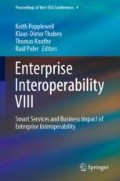Abstract
The risk and vulnerability analysis of buildings identifies buildings with high exposure to natural hazards. It is crucial to prevent or reduce damage and economic loss for the construction and property management industry. The government, as well as private landowners, benefit from risk and vulnerability assessment of their real estate portfolio. In this paper, we propose a semantic-enhanced method to simplify the risk and vulnerability assessment process and improve interoperability of real estate and natural hazards data. The method relies on the publication and integration of data from various sources as linked data. Visualization of the integrated data is also presented, together with application scenarios.
Access this chapter
Tax calculation will be finalised at checkout
Purchases are for personal use only
Notes
- 1.
- 2.
- 3.
- 4.
- 5.
- 6.
- 7.
- 8.
- 9.
- 10.
- 11.
- 12.
- 13.
- 14.
- 15.
- 16.
- 17.
References
Field, C. B. (Ed.). (2012). Managing the risks of extreme events and disasters to advance climate change adaptation: Special report of the intergovernmental panel on climate change. Cambridge University Press.
Opach, T., & Rød, J. K. (2013). Cartographic visualization of vulnerability to natural hazards. Cartographica: The International Journal for Geographic Information and Geovisualization, 48(2), 113–125.
Vilches-Blázquez, L. M., Villazón-Terrazas, B., Corcho, O., & Gómez-Pérez, A. (2014). Integrating geographical information in the Linked Digital Earth. International Journal of Digital Earth, 7(7), 554–575.
Saavedra, J., Vilches-Blázquez, L. M., & Boada, A. (2014). Cadastral data integration through Linked Data.
Shi, L., Sukhobok, D., Nikolov, N., & Roman, D. (2017, September). Norwegian state of estate report as linked open data. In OTM confederated international conferences “On the move to meaningful internet systems” (pp. 445–462). Cham: Springer.
Peereboom, I. O. (2011). Identification of areas exposed to flooding in Norway at a national level.
Peereboom, I. O. (2013). Flood mapping for PFRA and NVE’s spatial planning guidelines. In Nve (Ed.). NVE.
Rød, J. K., Opach, T., & Neset, T. S. (2015). Three core activities toward a relevant integrated vulnerability assessment: Validate, visualize, and negotiate. Journal of Risk Research, 18(7), 877–895.
Shi, L., Nikolov, N., Sukhobok, D., Tarasova, T., & Roman, D. (2017). The proDataMarket ontology for publishing and integrating cross-domain real property data. Journal “Territorio Italia. Land Administration, Cadastre and Real Estate”, 2, 1. https://doi.org/10.14609/Ti_2_17_1e.
Acknowledgements
The work has been funded by the European Commission under the projects proDataMarket (Grant number: 644497) and euBusinessGraph (Grant number: 732003). The authors would like to thank the proDataMarket consortium for additional contributions.
Author information
Authors and Affiliations
Corresponding author
Editor information
Editors and Affiliations
Rights and permissions
Copyright information
© 2019 Springer Nature Switzerland AG
About this paper
Cite this paper
Shi, L., Pettersen, B.E., Roman, D. (2019). Enabling Semantic Interoperability for Risk and Vulnerability Analysis of Public Buildings. In: Popplewell, K., Thoben, KD., Knothe, T., Poler, R. (eds) Enterprise Interoperability VIII. Proceedings of the I-ESA Conferences, vol 9. Springer, Cham. https://doi.org/10.1007/978-3-030-13693-2_12
Download citation
DOI: https://doi.org/10.1007/978-3-030-13693-2_12
Published:
Publisher Name: Springer, Cham
Print ISBN: 978-3-030-13692-5
Online ISBN: 978-3-030-13693-2
eBook Packages: EngineeringEngineering (R0)

